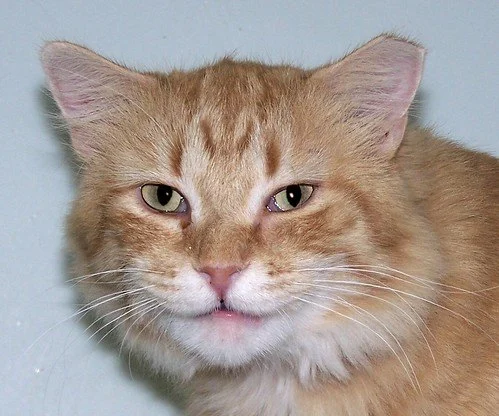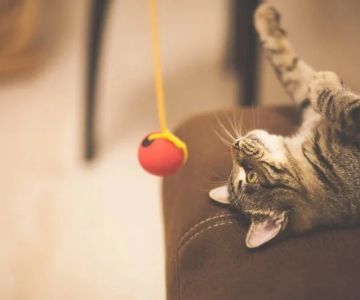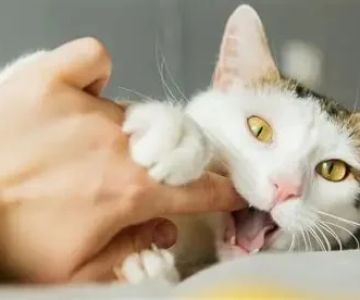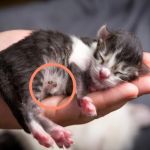
1. Understanding Ear Notching in Kittens
If you've recently adopted a kitten or noticed a cat with a notched ear, you might be wondering what that marking means. Ear notching is a common practice used in Trap-Neuter-Return (TNR) programs for feral cats. The notch is usually a small, surgical cut made at the tip of a cat’s ear, and it serves as a visual indicator that the cat has been spayed or neutered. This method plays a crucial role in helping control the overpopulation of feral cat colonies, and it's a vital aspect of humane animal management practices.

Backyard Feeding Station / Madison Ohio
7188 N Ridge Rd, Madison, OH 44057, USA
2. What is TNR and How Does It Work?
TNR, which stands for Trap-Neuter-Return, is a widely recognized and effective method for managing feral cat populations. The program works by humanely trapping feral cats, taking them to a veterinary clinic for spaying or neutering, and then returning them to their original location. The ear notching is performed during the surgery to ensure that the cat is easily identifiable if trapped again in the future. This helps prevent the same cats from being trapped, spayed, or neutered multiple times.

Pinnacle Veterinary Center
Santa ClaritaLos Angeles CountyCalifornia
23026 Soledad Canyon Rd, Santa Clarita, CA 91350, USA
1. Trap: The First Step
The first step in a TNR program is trapping the feral cats. This is typically done using humane traps designed to safely capture the cat without harm. Trapping is often done by volunteers or local animal shelters, who ensure the cats are safely caught without causing stress or injury to them.
2. Neuter/Spay: The Surgery
Once trapped, the cat is taken to a veterinary clinic where they undergo spaying or neutering. This surgery prevents future reproduction and helps control the feral cat population. During the procedure, a small section of the cat's ear is removed, which is how the ear notch is created. This marks the cat as "fixed" and ready to be returned to its environment.
3. Return: Back to the Wild
After the surgery and recovery, the cat is returned to the place where it was trapped. The cat will continue to live in its original environment, but without the risk of further reproduction. The benefits of this process include a decrease in the overall feral cat population, as well as a reduction in the number of kittens born each year.
3. Why Is Ear Notching Important?
Ear notching serves several key purposes in TNR programs. Here are the main reasons why this practice is vital for feral cat population control:
1. Easy Identification
The most immediate benefit of ear notching is that it allows people to quickly identify whether a cat has already been spayed or neutered. Without this marking, feral cats may be trapped, spayed, and then trapped again, wasting valuable resources and creating unnecessary stress for the animal.
2. Reduces Overpopulation
By identifying cats that have already been fixed, ear notching helps prevent repeated trapping, thereby reducing the overall number of feral cats. This is essential in controlling the population, as it ensures that only unspayed or unneutered cats are trapped for the procedure.
3. A Humane Approach to Animal Control
TNR is a humane and effective method of controlling feral cat populations, and ear notching is a key component. Unlike other methods of control, such as culling or abandonment, TNR provides a long-term solution to the problem by preventing overpopulation without causing harm to the animals.
4. What Does a Notched Ear Mean for Your Kitten?
If your kitten has a notched ear, it likely means that it was part of a TNR program. While this might initially seem concerning, it’s actually a sign that the kitten has already been through a spaying or neutering procedure. For kittens that are part of feral colonies, TNR helps ensure that they don’t contribute to the population growth, and that they can live healthier, more stable lives without the risk of unwanted pregnancies.
1. Does a Notched Ear Indicate a Health Issue?
A notched ear does not indicate any health issues or problems for your kitten. The procedure is done safely and does not affect the cat's overall health. If you’ve recently adopted a kitten with a notched ear, it’s important to understand that it is simply a sign of their participation in a responsible and humane spaying or neutering program.
2. What Should You Do If Your Kitten Has a Notched Ear?
If you adopt a kitten with a notched ear, there is no need for further spaying or neutering. The kitten is already fixed and will not contribute to the overpopulation of cats. Ensure that your kitten receives regular veterinary check-ups and vaccinations to maintain its health and well-being. Additionally, if your kitten shows signs of illness or discomfort, don’t hesitate to consult your vet.
5. Success Stories of TNR Programs
TNR programs have had a profound impact on reducing the feral cat population in various communities. Here are a few success stories that highlight the importance and effectiveness of TNR:
1. The Impact of TNR in Suburban Areas
In suburban communities, TNR programs have been particularly successful in managing feral cat populations. In many areas, local animal shelters and volunteer organizations have worked together to trap, neuter, and return thousands of feral cats, leading to a noticeable decrease in the number of kittens born each year. Not only has this reduced the strain on local shelters, but it has also created healthier, more stable cat colonies.
2. The Role of TNR in City Cat Management
TNR has also made a significant difference in urban areas. Major cities across the U.S. have embraced TNR as the primary method of feral cat control. By investing in TNR, these cities have been able to reduce the number of stray kittens and promote healthier, more sustainable cat populations. In many cases, TNR has been recognized as a successful, humane alternative to traditional methods of animal control.
6. How to Support TNR Programs
If you're passionate about helping feral cats and supporting TNR programs, there are several ways you can get involved:
1. Volunteer Your Time
Many TNR programs rely on volunteers to help trap, transport, and care for cats. Volunteering your time can make a big difference in the lives of feral cats. Look for local animal shelters or organizations that run TNR programs and find out how you can assist.
2. Donate to TNR Organizations
TNR programs require funding to cover the costs of trapping, spaying, neutering, and returning cats to their colonies. Donating to these programs can help provide the necessary resources to continue this important work.
3. Educate Your Community
Raising awareness about TNR and the benefits it offers is key to creating widespread support for the program. Educate your friends, family, and neighbors about how TNR works and why it’s important for controlling feral cat populations in a humane manner.
In conclusion, a notched ear is a sign that a kitten has been part of a successful TNR program, helping to prevent overpopulation and ensure that cats live healthier lives. By supporting TNR, you can play a role in reducing the number of unwanted kittens and promoting the well-being of feral cats in your community. For more information on how to get involved, visit Omnia Pet to find the best products, services, and support for your feline friends.







 Hollywood Feed4.0 (184 reviews)
Hollywood Feed4.0 (184 reviews) Brew Biscuits5.0 (2 reviews)
Brew Biscuits5.0 (2 reviews) All Friends Animal Hospital4.0 (446 reviews)
All Friends Animal Hospital4.0 (446 reviews) Kittylandkittens LLC0.0 (0 reviews)
Kittylandkittens LLC0.0 (0 reviews) Village Animal Clinic4.0 (212 reviews)
Village Animal Clinic4.0 (212 reviews) Rift Lake Aquatics4.0 (165 reviews)
Rift Lake Aquatics4.0 (165 reviews) Understanding Pet Insurance: What Does It Actually Cover?
Understanding Pet Insurance: What Does It Actually Cover? How to Keep Your Kitten's Eyes Clean and Free of Discharge
How to Keep Your Kitten's Eyes Clean and Free of Discharge The Truth About Heartworm Disease: Prevention is Cheaper Than Cure
The Truth About Heartworm Disease: Prevention is Cheaper Than Cure Why Is My Kitten's Belly Button Showing? | Omnia Pet
Why Is My Kitten's Belly Button Showing? | Omnia Pet Why Does My Cat Bite Me Gently? Love Bites Explained
Why Does My Cat Bite Me Gently? Love Bites Explained How to Stop Your Kitten from Getting into Cabinets
How to Stop Your Kitten from Getting into Cabinets